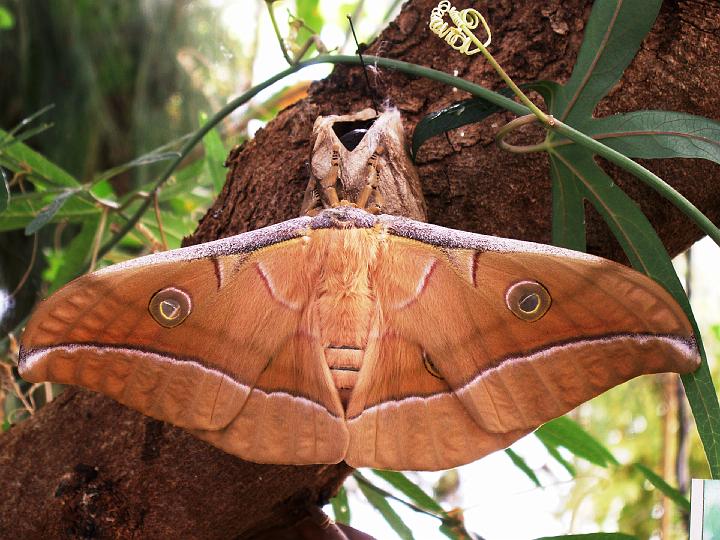
Antheraea pernyi(Antheraea pernyi)
Phylum —arthropoda
Class —insecta
Order — lepidoptera
Family —saturniidae
Genus –antheraea
Appearance
These are large butterflies with a wingspan of 100-152 mm. Females are larger than males. The body and wings are densely covered with hairs. The main color varies from yellow-gray to red-brown. In the middle of the wings there are transverse dark stripes, and there arelilac stripeson the outer part. The rounded eyespots on the wings are transparent ones.
Habitat
It lives in China, Korea and Japan. It is acclimatized in south-eastern Spain and on the island of Majorca.
Behavior
A nocturnal species which frequents open deciduous and evergreen forests dominated by oaks.Both sexes of this species are readily attracted to light and can be found by day 'resting' on posts and walls below these.
The species is a sedentary one. It gives 2 generations per year.Butterflies fly in May-June and in July-September.
Diet
The caterpillars develop on the leaves of oak; they can also feed on the leaves of willows, birch, hornbeam and hazel.
Life cycle
Antheraea pernyiusually has two generations per year. The pupae of the second generation overwinter. After mating, which takes place at night, the females lay eggs. The average number of eggs laid is 160-170, in the summer generation it reaches 250. After 15 days, small black caterpillars emerge from the eggs, which after the first molt change their color to green with a yellowish or bluish tinge. Within 35-40 days, they undergo four molts and reach a length of 9 cm. They begin to curl dense silk cocoons. Curling cocoons lasts from three to five days; after that, the caterpillar becomes immobile, and then sheds and turns into a pupa, the development of which lasts 25-29 days. Pupae of the first generation are formed in mid-June; wintering pupae of the second generation-in mid-September.
In captivity
Plastic cages, small aquariums or large cans are used as a living place for caterpillars, The bottom of the container is covered with hygroscopic material – paper, sand, peat, sawdust. The forage plant is placed in a small jar with water, and the stems are lined with cotton wool or paper to prevent the caterpillars from entering the water. The change of the forage plant is carried out with a frequency that does not allow it to rot or dry out. The aquarium is placed in a place inaccessible to direct sunlight, closed with a special lid with windows made of fine mesh, which allows you to adjust the required level of humidity in it.
Before pupating the caterpillars, if this species does not involve pupation in the ground, it is necessary to place pieces of bark or cardboard in the cage or aquarium, to which the caterpillar will be able to attach its pupa or cocoon. The pupae are left in a state of rest, and the cocoons are carefully placed on a moistened litter. By the time the butterflies come out of the pupae or cocoons in the aquarium, supports are necessarily arranged from branches, pieces of bark or paper, on which the butterflies can climb to spread their wings.
For mating butterflies, it is advisable to transplant them into a mesh cage or a mosquito canopy, the eggs laid can be stored in a small hatchery, maintaining the necessary humidity. Before the larvae enter the cage, you need to place fresh leaves of the forage plant.
 Russian
Russian
 English
English























